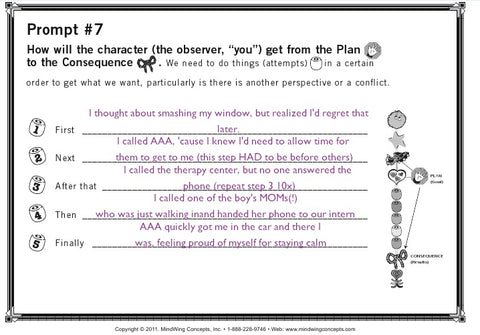Menu
-
- Home
-
About Us
-
The Approach
-
Focus Areas
-
MindWing Learning
-
Learning Resources
-
SHOP
-
Blog
-
- About MindWing
- Our People
- Contact Us
- Your Account
- Login
-
United States (USD $)

Sharing our own Stories & Social Problem Solving using Story Grammar Marker®
by Sean Sweeney September 01, 2011 3 min read
Over the summer I had the kind of “Kick-Off” that we all hope to avoid in the course of our ho-hum days. It was a 95-degree school day and I was leaving one setting to go to my private practice and run a social skill group. As I opened my passenger side door to put my bag in the car, an oppressive blast of heat enveloped me. I decided stupidly that it would be a good idea to lean over and start the car so the A/C could have, you know, a millisecond to cool down the car as I walked around toward the driver side. Of course when I got there the door had locked automatically, as it had on the other side. Ugh.
As I stewed in the heat waiting for the auto club to help me out, I thought about the group I had to run shortly (with a dwindling amount of time to actually get there), and how using Story Grammar Marker® and sharing this story could possibly help them when I arrived. I find that when we open up to kids a bit and share real-life stories, their engagement level often increases as they realize that we are actually real people who make silly mistakes and have Kick-Offs just like they do. Having received a preview of MindWing’s upcoming new book, Facilitating Relationships, I also realized that my story could use what is called a Social Problem Solving Prompt, a key intervention outlined in the new book (and supported by the National Autism Center in its recommendation for story-based interventions). In this new book there are 18 different Social Problem Solving Prompts for social situations to help your students to recognize, think about and talk about a social situation including, characters, settings, kick-offs, feelings, conflicts, plans, perspectives and consequences.
When I got to our therapy center 10 minutes late, my graduate student had skillfully and promptly started group (see below for how this occurred), and they were sharing their own weekly news over snack. It seemed a good time to share my news, and I had grabbed a Student Story Grammar Marker as I passed a treatment room. “So, I have a story for you...” I started, and relayed the setting and Kick-Off. A good teaching point immediately ensued when one of the boys shouted out “HA HA!” I cued him that while my positive body language while relaying the story could give him a clue that it was OK to smile and laugh a bit WITH me, what he had just done was more in the realm of teasing and made me think an annoyed thought! From there, my story really became a Problem Solving Prompt and an interactive discussion as I asked the boys a lot of questions while using the SGM for visual support:
- How do you think I felt? Hot, annoyed, worried, angry were some suggestions.
- Which Unthinkable can you guess almost got in my brain? Glass Man, who makes us overreact to problems and SHATTER! (See Michelle Garcia Winner and Stephanie Madrigal’s Superflex™ Curriculum)
- Can you guess what my plan was? (This one took some scaffolding to elicit that my plan was to get into my car and get to group on time, or get the message to the center that someone needed to start group for me).
We then talked through what my problem solving steps were. Here’s a preview of what that could look like using one of the Prompts from Facilitating Relationships:

In effect, something as simple as my silly keys story could provide a quick teachable moment that touched on a lot of goals for this particular group: narrative organization, social inference, self-regulation, self-talk, problem solving and interpersonal skills, among others.
Additionally, we all got to talk about what my “Note To Self” should be (see Sara Ward’s excellent work on this concept) after this experience: Don’t start the car unless you are seated in the driver’s seat!
Sean Sweeney
Sean Sweeney, MS, MEd, CCC-SLP, is a speech-language pathologist and technology specialist working in private practice at the Ely Center in Needham, MA, and as a clinical supervisor at Boston University. He consults to local and national organizations on technology integration in speech and language interventions. His blog, SpeechTechie (www.speechtechie.com), looks at technology “through a language lens.” Contact him at sean@speechtechie.com.
Leave a comment
Comments will be approved before showing up.
